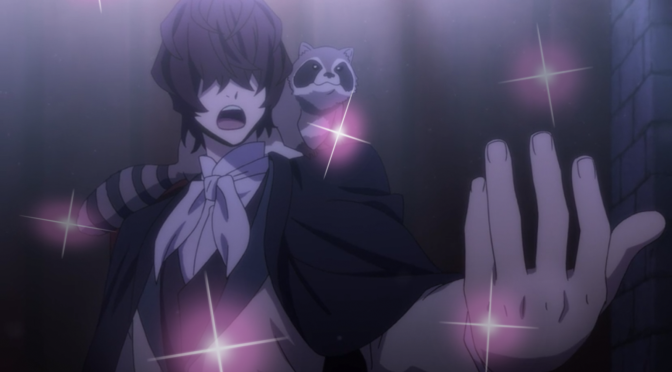For Poe’s birthday, a short presentation I gave about an anime that decided to make him a cute awkward young man.
On March 24, 2017, I chaired a panel I organized on “The Pop Culture Afterlife of Edgar Allan Poe,” looking at the author’s continued influence on recent film, television, and other media. Before presentations began, and to fill in the time resulting from a panelist that unfortunately was unable to attend, I gave brief remarks about one story inspired by Poe’s works. On what would be Poe’s birthday today, I would like to share a revised copy of the presentation I gave.
I have written before about Bungo Stray Dogs, so I hope these edited remarks from my earlier presentation help clarify how well this series pulls various divergent details from one author’s works and forces them all into one character that surprisingly can show the wide range of their literary output. One of the greatest strengths of Bungo Stray Dogs is how it combines tropes common to a lot of manga and anime with details that are taken from the real lives of literary giants, making more indistinct the line between truth and fiction. And with an author like Poe, so prone to hoaxes and trickery, and whose biography is plagued by fictions forced into it by his editor and even us scholars, it’s apt for Bungo Stray Dogs to keep it unclear just how much of what we read in this fictionalized version of Poe is like the author really was, and how much of it is just literary shorthand.
Below are my revised remarks:
I would like to take a few minutes to discuss how Poe remains so popular in current popular culture.
It’s popular to inject real-life historical figures into your fiction.
Bungo Stray Dogs is a novel and Japanese comics series written by Kafka Asagiri and illustrated by Sango Harukawa, featuring characters with the same names of famous real-life authors, as well as superpowers related to those authors’ works.
And one of those authors is of course Edgar Allan Poe.
In Bungo Stray Dogs, creators Asagiri and Harukawa pay close attention to the history, works, and pop culture aura that surrounds Poe. This version of the author is introduced as a villain against the comparatively more heroic Ranpo, named for real-life Japanese mystery novelist Ranpo Edogawa (1894-1965), who was influenced by the real-life Poe. This version of Poe has the superpower called “Black Cat in the Rue Morgue,” which takes its name from the tales “The Black Cat” (1841) and “Murders in the Rue Morgue” (1841). Like the characters written by the real-life Poe and Ranpo, these rivals are actual detectives with skills at ratiocination and induction, Ranpo thinking his skill is itself a superpower (spoiler: it isn’t–Ranpo is just really good at detective work but imagines he has a superpower to feel special). Like the narrator of The Cask of Amontillado (1846), Poe obsesses over how Ranpo embarrassed him and seeks vengeance. And like Poe’s writings with unreliable narrators, the fictional murderer in this fictional story turns out to be Ranpo himself. In this way, Bungo Stray Dogs combines two of Poe’s most notable characters, the detective and the unreliable narrator, into one concise mass.
The presence of Poe in this Japanese animated series has provoked varied reactions, as we see how anime has altered Poe to make him suit a set of cultural expectations and narrative shorthand. Upon showing a friend a bit of this version of the author, my fellow anime fan complained, “They made Poe bishie?!”–Japanese for “pretty boy.”
As well, like many anime characters, Poe here has an animal sidekick–surprisingly, not the black cat which Poe wrote and which we see as Sailor Moon’s guardian Luna, or Rin Okumura’s familiar Kuro the demon cat in Blue Exorcist.
(Granted, Poe’s narrator killed the titular Black Cat, so perhaps that was for the best.)
Instead, Asagiri and Harukawa give Poe a pet raccoon named Karl, an animal which no evidence suggests he actually owned. This is the intertextual cleverness of Asagiri and Harukawa, as they combine fact with literary license, incorporating the pet raccoon from another fictionalization about Poe, the 2012 bio-pic The Raven starring John Cusack.
To conclude these brief remarks, it is apt that Bungo Stray Dogs gives Poe, as his superpower, the ability to suck in readers, an accomplishment we see still holds to his work up to this day.
Thank you for reading up to the end. As an independent scholar, I appreciate anyone who shares my content with interested readers. I’m available for teaching, copyediting, research assistance, and writing projects, and I can be reached via email. WordPress comments are welcome.

